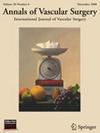MASC(手臂活动度评分):一种评估疑似胸廓出口综合征患者功能损害的短且侧特异性工具。
IF 1.6
4区 医学
Q3 PERIPHERAL VASCULAR DISEASE
引用次数: 0
摘要
简介:胸廓出口综合征(TOS)以单侧或双侧颈-胸-臂区臂丛和/或锁骨下血管的位置压迫为特征。功能影响目前是通过不允许特定方面评估的问卷来评估的。手臂活动能力评分(MASC)问卷设计简短,评估疑似TOS的功能影响,强调动态任务和侧面特定评估。方法:前瞻性招募200例因疑似TOS而转诊至昂热大学医院血管内科的患者。他们完成了手臂和肩部残疾(DASH)和MASC问卷。可行性评估采用McNemar测试比较可评分问卷的比率。计算Pearson相关系数来检验受影响最严重的手臂的MASC与DASH和Quick-DASH (Q-DASH)评分之间的关系。结果:MASC的可评分问卷率(98.5%)显著高于DASH (90.5%, p< 0.001)或Quick-DASH (94%, p< 0.001)。最严重组的MASC评分与DASH、Q-DASH评分的Pearson相关系数为0.835 (p)。结论:MASC问卷具有良好的可行性,且与DASH、Quick-DASH问卷具有较强的相关性。它为疑似TOS患者的症状的侧边性提供了有价值的见解。未来的研究应探讨在治疗患者的纵向随访中对MASC变化的敏感性,以验证这些初步发现。本文章由计算机程序翻译,如有差异,请以英文原文为准。
The Mobility of Arm Score: A Short and Side-Specific Tool to Assess Functional Impairment in Patients with Suspected Thoracic Outlet Syndrome
Background
Thoracic outlet syndrome (TOS) is characterized by the positional compression of the brachial plexus and/or subclavian vessels in the cervico-thoraco-brachial region, unilaterally or bilaterally. The functional impact is currently assessed by questionnaires that do not allow side-specific assessments. The Mobility of Arm Score (MASC) questionnaire was designed to be short and assess the functional impact of suspected TOS, emphasizing dynamic tasks and side-specific evaluations.
Methods
We prospectively recruited 200 patients referred to the vascular medicine department of the University Hospital of Angers for suspected TOS. They completed the Disability of Arm, Shoulder, and Hand (DASH) and MASC questionnaires. Feasibility was evaluated by comparing the rates of scorable questionnaires using the McNemar test. Pearson correlation coefficients were calculated to examine the relationship between MASC from the most affected arm and the DASH and Quick-DASH (Q-DASH) scores.
Results
The rate of scorable questionnaires was significantly higher for the MASC (98.5%) than for the DASH (90.5%; P < 0.001) or Q-DASH (94%; P < 0.001). Pearson correlation coefficients between the MASC score for the most affected arm and the DASH and Q-DASH scores were 0.835 (P < 0.001) and 0.825 (P < 0.001), respectively.
Conclusion
The MASC questionnaire demonstrated excellent feasibility and a strong correlation with the DASH and Q-DASH questionnaires. It offers valuable insights into the laterality of the symptoms in patients with suspected TOS. Future research should explore the sensitivity to changes of the MASC in the longitudinal follow-up of treated patients to validate these preliminary findings.
求助全文
通过发布文献求助,成功后即可免费获取论文全文。
去求助
来源期刊
CiteScore
3.00
自引率
13.30%
发文量
603
审稿时长
50 days
期刊介绍:
Annals of Vascular Surgery, published eight times a year, invites original manuscripts reporting clinical and experimental work in vascular surgery for peer review. Articles may be submitted for the following sections of the journal:
Clinical Research (reports of clinical series, new drug or medical device trials)
Basic Science Research (new investigations, experimental work)
Case Reports (reports on a limited series of patients)
General Reviews (scholarly review of the existing literature on a relevant topic)
Developments in Endovascular and Endoscopic Surgery
Selected Techniques (technical maneuvers)
Historical Notes (interesting vignettes from the early days of vascular surgery)
Editorials/Correspondence

 求助内容:
求助内容: 应助结果提醒方式:
应助结果提醒方式:


